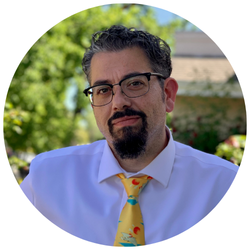Los espacios de escritura son cosas intensamente personales. Todos tenemos un lugar —quizás incluso más de uno— donde nos encanta escribir. Si tenemos suerte, podemos organizarlo a nuestro gusto.
La clave es crear un espacio que te ayude a concentrarte y te inspire. Porque ese es el espacio ideal para escribir: ya sea un punto fijo en tu casa o un lugar que lleves contigo, el objetivo de este espacio no es ser bonito o profesional, ni impresionar a los demás ni quedar bien en redes sociales. El objetivo es crear un ambiente que te anime a escribir .
Claro, cómo se ve eso depende de qué tipo de persona seas y de lo que te funcione. Gran parte de crear un espacio de escritura que te ayude a concentrarte se trata de conocerte personalmente.
En mi caso, tengo un escritorio frente a una ventana, desde donde puedo ver el frente de mi casa. Es un escritorio de pie para poder estirarme y ponerme de pie cuando quiero. También tengo una silla carísima que me ayuda a no dolerme la espalda mientras estoy sentado.

El espacio de trabajo de Bryan
Algunos escritores encuentran las ventanas demasiado distrayentes, por lo que su espacio se ve más fácilmente pirateado si colocan su escritorio frente a una pared. Stephen King aconsejaba a los escritores que colocaran sus escritorios en una esquina de la habitación:
Cada vez que te sientes a escribir, recuerda por qué no es en el centro de la habitación. La vida no es un sistema de apoyo para el arte. Es al revés.
Asegurarse de que la ergonomía y la iluminación sean las adecuadas también es importante. La ergonomía no se limita solo al teclado. Asegúrate de que tu escritorio esté a la altura correcta y de no lesionarte al trabajar. Estírate y ponte de pie con frecuencia.
Asegúrate de que la iluminación de la habitación te permita ver lo que haces sin cansar la vista, pero que también fomente tu creatividad. En mi caso, las cálidas luces Edison parecen funcionar cuando no hay luz solar. A veces, temprano en las mañanas de invierno, la luz de las velas me anima a escribir en mi diario.

Mantener una temperatura agradable también es vital. Si te preocupa pasar demasiado calor o demasiado frío, no estás pensando en escribir.
El desorden en el escritorio es algo que varía según el escritor. Personalmente, puedo manejar el desorden en mi escritorio, los restos de los últimos proyectos y las tarjetas de visita de mis últimas apariciones, hasta cierto punto. Después, no puedo concentrarme y tengo que limpiarlo todo para empezar de nuevo con mi desorden. Lo difícil es reconocer cuándo es el desorden el que inhibe mi productividad y no algo más que me afecta y me hace procrastinar.
A veces, cambiar por completo de espacio de trabajo añadirá novedad a tu rutina y te permitirá concentrarte en el trabajo con un ligero cambio de ritmo. Esa cafetería, bar o biblioteca podría ser la oficina ideal fuera de la oficina para cumplir con tu próxima fecha límite.

Espacio de trabajo de la escritora libre @msanniecathryn
Tu espacio de trabajo digital también es importante.
Hay muchas cosas que puedes hacer para aumentar la concentración y la productividad con las herramientas digitales que utilizas. El legendario escritor de cómics Brian K. Vaughan dijo una vez:
"El bloqueo del escritor es simplemente otra palabra para los videojuegos".
Elimina todas las aplicaciones de juegos de tu teléfono. Cierra aplicaciones como Discord o Slack y activa el modo "No molestar". Para mí, lo mejor es cambiar mi forma de escribir. Cambiar mi método de entrada.
Mi escritura libre es mi forma de redactar mis novelas, precisamente porque me proporciona un espacio de trabajo sin distracciones. Si tengo dificultades con una escena en particular, puedo hacer el trabajo del día con lápiz y papel. O con mi máquina de escribir. Cambiar la forma de escribir activará diferentes partes del cerebro y te permitirá avanzar en lugar de consultar los mismos tres sitios web una y otra vez en un bucle constante durante días y días.
Lo más importante es descubrir qué trucos funcionan para ti . Experimenta.
La prueba y el error son la mejor manera de descubrir cuál es tu espacio de trabajo ideal para tu proceso creativo.
Regresar a "Trucos para mejorar la productividad al escribir"




























